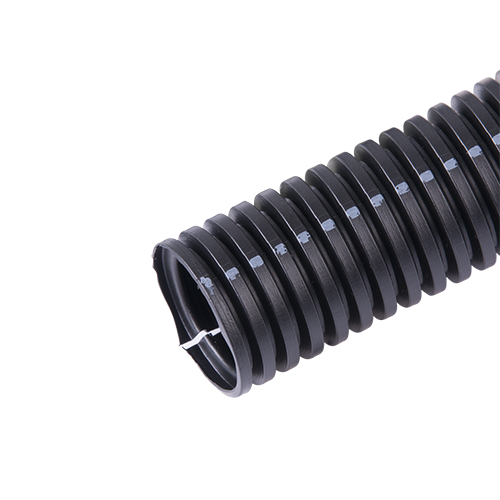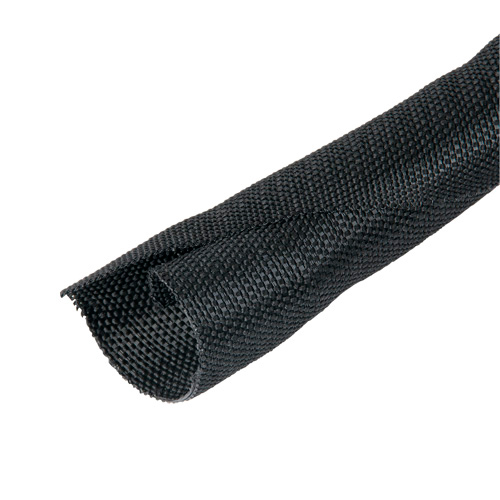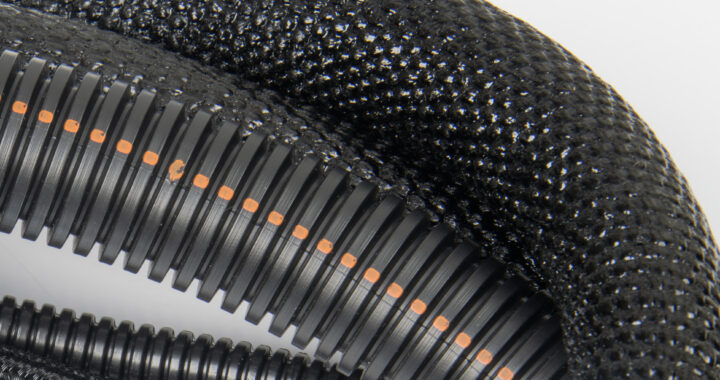When it comes to managing and protecting electrical wiring, choosing the right solution is critical for safety, durability, and efficiency. Two popular options are plastic rigid conduit loom and smooth braided or knitted sleeving loom. Both serve to organize and protect cables, but they differ significantly in design, application, and performance. This blog post compares these two solutions to help you make informed decisions for your wiring projects.
What is Plastic Rigid Conduit?

Plastic rigid conduit or loom made by Drossbach, is made from Nylon, Polyethylene (PE) and Polypropylene (PP), it is a sturdy, non-flexible tubing designed to protect electrical wiring in residential, commercial, and industrial settings. It’s commonly used in environments where cables need robust protection from physical damage, moisture, or harsh conditions. Rigid conduit is often installed along walls, floors, or underground, providing a structured pathway for wiring.
Key Features of Plastic Rigid Conduit
- Durability: Offers high resistance to impacts, crushing, and applied strain, making it ideal for heavy-duty environments.
- Chemical Resistance: Provides good protection against an extensive range of chemicals, including automotive fluids and oils.
- Specialized Formulations: Can be formulated with fire-retardant (FR), anti-UV (for nylon), and anti-rodent properties for enhanced performance.
- Watertight Option: Unslit versions are watertight, perfect for outdoor or wet environments.
- Slit Design: Slit structures allow easier reopening for inspection or cable changes, improving maintenance flexibility.
- Light and Flexible: Despite its rigidity, modern designs are relatively lightweight compared to smooth braided or knitted sleeving.
- Temperature Range: Suitable for long-term use in temperatures from -40°F to 275°F.
- Fire Resistance: Stops burning and prevents electrical leaks, enhancing safety in high-risk areas.
- Installation: Requires precise measurements and fittings (e.g., connectors, elbows) and is typically secured with screws or adhesives. It’s less flexible, making it better suited for straight runs or fixed installations.
Best Applications for Plastic Rigid Conduit
- Outdoor and Underground: Perfect for protecting wiring in exposed or buried installations, such as outdoor lighting or utility lines, especially with watertight unslit versions.
- Commercial and Industrial Settings: Used in factories, warehouses, or offices where cables need protection from heavy traffic or equipment.
- Permanent Installations: Ideal for long-term setups where wiring won’t need frequent reconfiguration.
What is Smooth Braided or Knitted Sleeving Loom?

Smooth braided or knitted sleeving loom, often made from materials like polyester (PET), nylon, or fiberglass, is a flexible, woven tubing designed to bundle and protect wires. Its open-weave or tightly knitted construction allows it to conform to various cable shapes while providing protection and organization. Unlike rigid conduit, sleeving is lightweight and adaptable, making it popular for dynamic environments.
Key Features of Smooth Braided or Knitted Sleeving
- Flexibility: Highly flexible with excellent bending ability, it easily fits around irregular cable bundles and navigates tight spaces or complex configurations.
- Tighter Bundling: Allows for compact bundling of large amounts of wires or harnesses, ideal for space-constrained setups.
- Ease of Installation: Self-closing (knit) or expandable (braid) designs make wire insertion quick and simple, with split options for easy retrofitting.
- Aesthetic Appeal: Available in various colors and styles, it enhances the visual appeal of wiring setups, making it ideal for visible installations.
- Heat and Moisture Management: The open-weave design allows heat to dissipate and moisture to drain, reducing the risk of overheating or corrosion.
- Temperature Range: Fiberglass braids can withstand extreme temperatures up to 1200°F, while PET and nylon options typically handle lower ranges.
- Abrasion Resistance: Offers good protection against abrasion, though less resistant to crushing or strain compared to rigid conduit.
- Chemical and Water Resistance: Braided structures typically offer no chemical protection or water resistance, limiting their use in harsh environments.
- Fraying Considerations: May fray if cold-cut, requiring a hot knife for clean edges.
- Cost-Effective: A cheap and convenient way to bundle large amounts of wires or harnesses.
Best Applications for Smooth Braided or Knitted Sleeving
- Automotive and Marine: Protects wiring in engines, control panels, or vehicle electronics, where flexibility and compact bundling are crucial.
- Home and Office: Organizes cables for computers, home theaters, or networking systems, improving aesthetics and reducing clutter.
- Dynamic Environments: Ideal for robotics, manufacturing, or applications requiring frequent cable adjustments or retrofitting.
Comparing the Two: Key Differences
| Feature | Plastic Rigid Conduit | Smooth Braided/Knitted Sleeving |
|---|---|---|
| Material | Nylon, Polyethylene (PE) and Polypropylene (PP) | Polyester, nylon, fiberglass, or other fibers |
| Flexibility | Rigid, suited for fixed installations | Highly flexible, excellent bending ability |
| Durability | High resistance to impact, crush, and strain | Good abrasion resistance, less crush-resistant |
| Installation | Requires fittings, tools, and precise planning | Easy with self-closing or expandable designs |
| Environmental Protection | Watertight (unslit), chemical/UV resistant | No chemical/water resistance, heat-dissipating |
| Aesthetics | Can be painted to match decor, less visually appealing | Sleek, colorful options for professional look |
| Cost | Generally higher due to materials and installation | More cost-effective, especially for small projects |
| Temperature Range | -40°F to 275°F | Up to 1200°F (fiberglass braids) |
| Applications | Outdoor, underground, industrial | Automotive, home/office, dynamic setups |
Which Should You Choose?
The choice between plastic rigid conduit and smooth braided or knitted sleeving loom depends on your specific needs:
Choose Plastic Rigid Conduit if you need:
- Robust protection against impact, chemicals, and crushing for outdoor, underground, or industrial applications.
- A permanent, watertight solution with minimal maintenance and specialized features like anti-UV or anti-rodent properties.
- Enhanced safety for high-risk environments with a temperature range of -40°F to 275°F.
Choose Smooth Braided or Knitted Sleeving Loom if you need:
- Flexibility and tighter bundling for complex or frequently adjusted wiring setups in automotive, home, or office environments.
- A cost-effective, aesthetically pleasing solution with easy installation for retrofitting or temporary projects.
- High-temperature resistance (up to 1200°F with fiberglass) for specific applications like high-heat environments.
Conclusion
Both plastic rigid conduit and smooth braided or knitted sleeving loom offer valuable solutions for cable management, but they cater to different needs. Rigid conduit excels in durability, chemical resistance, and protection for fixed, high-risk environments, with specialized features like watertight and anti-rodent options. Braided or knitted sleeving provides flexibility, tighter bundling, and ease of use for dynamic setups, with fiberglass options for extreme temperatures. By assessing your project’s environment, budget, and requirements, you can select the best option to ensure safe, organized, and efficient wiring.
Consider rigid conduit for heavy-duty applications like factories or outdoor installations, and sleeving for office or automotive projects requiring flexibility. Sleeving is often the go-to for home electronics due to its affordability and ease, while rigid conduit suits outdoor home improvements. Evaluate your needs and choose the solution that aligns with your goals!
